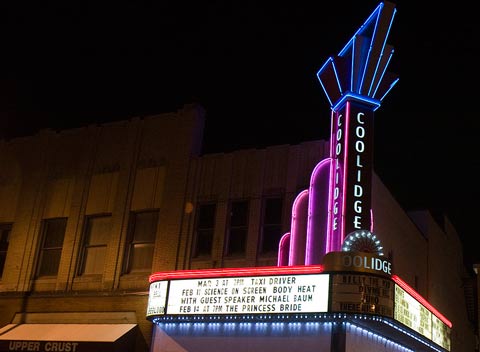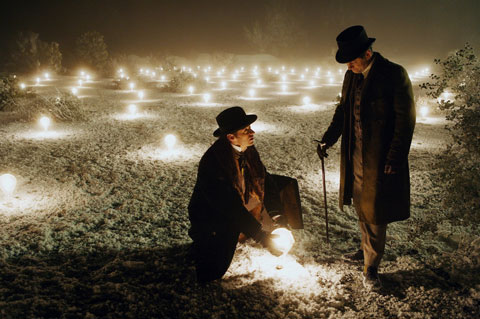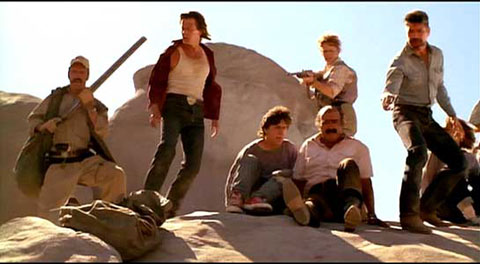Science on the Silver Screen
There’s now a film series for anyone who’s left a movie theater pondering deep questions like “Can electricity really reanimate the dead?” or “Will a seismometer alert me to the presence of giant killer worms?” and “How accurate is the depiction of time travel in Bill and Ted’s Excellent Adventure?”
Over the last eight years, the Coolidge Corner Theater’s Science on Screen series has integrated popular films with scientist-led discussions about everything from neuroscience to space travel. The film series started in a small theater outside of Boston where once every other month a researcher takes the place of previews before a classic movie and shares their work and the science in the film.
“What we do is we creatively pair feature films and documentaries with science and technology experts,” said Cheryl White, the program manager of the series. “The idea is to do a wide range, to appeal to a diverse audiences.”
 The Coolidge Corner Theater — birthplace of Science on Screen
The Coolidge Corner Theater — birthplace of Science on Screen An Excellent Adventure
The pairings can get pretty creative. Dozens of sci-fi films show people skipping through time with ease, and the theater brought in Edward Farhi, a physicist at MIT, to explain how someone might be able to travel back to the past.
“If you try to build a time machine, it will destroy the universe. General relativity won’t allow a-causal behavior,” Farhi said. He spoke in January of 2012 before the showing of one of the classics in the genre. “Bill and Ted’s Excellent Adventure is about time travel, so I spoke about the actual physics of time travel.”
Addressing a packed theater of over 400 people, Farhi said that moving quickly in time’s forward direction is easy. In General relativity, space travelers accelerating to near the speed of light can warp time. When they get going fast enough, one second on the rocket ship can seem like months, years or even decades to someone on Earth.
Going backwards, however, gets tricky. Farhi said that if engineers did try to build a working time machine, it would need at least half of all the energy that exists to send it backwards. Consequently, “going back in time is not really possible,” according to Farhi.
The theater brought in Farhi because he’s the local expert. He’s written papers about the logistics of time travel with some of the leading theorists in the field. He even spoke at a get-together for any time travelers who were in the “era.”
“The time travelers convention was an attempt to attract time travelers with cookies and milk and a festive atmosphere,” Farhi said. No bona fide chronological interlopers made it, as far as anyone could tell, but everyone who did show up enjoyed the cookies.
“The world we live in is strange and it is exciting,” Farhi said. “My goal when I give a public talk is to get people excited about real physics not just fictional physics.”
Talks like this form the backbone of Science on Screen. Since the program's start, the organizers have paired scientists with more than 50 movies including Night of the Living Dead, Star Trek and Groundhog Day. Scientists from fields as diverse as child psychology, marine biology, geology and fundamental physics have drawn huge crowds.
Tesla's Magic
Sometimes, the science connections are unexpected. In December of 2012, the theater showed director Christopher Nolan’s The Prestige, a film about rival magicians at the beginning of the 20th century. In it, musician David Bowie plays the enigmatic inventor and master of electricity, Nikola Tesla, the perfect opportunity for MIT physicist to talk about the creations and life of Tesla.
“He’s an inspiring figure, he’s a cautionary tale in many ways,” said Peter Fisher, a physics professor at MIT who spoke about the film. “He was a brilliant innovator, and he could build things, but he could only take them so far.”
Tesla helped electrify the world with alternating current and his three-phase power system. Together, the two innovations made it possible to transmit power over hundreds or even thousands of miles.
“Tesla saw that if you ever wanted to scale it up to a national power system this is how you would do it,” Fisher said. “It is absolutely the way that all electricity is transported today.”
Tesla spent the last years of his life working on a way to transmit power without wires, a charge Fisher and other researchers are developing to this day. He added also that the movie gave him a chance to talk about another parallel he saw between the past and today.
“The film takes place in turn of the century England and America, at a time when there was a lot of new technology,” Fisher said. He said that today, because of computers and the Internet, the world is at a similar kind of crossroads. New inventions and innovations are changing the world rapidly, and there are a lot of amazing, almost magical things people can do with them. But there’s also a lot of hoaxes and fakery surrounding technology as well – a theme that runs through the film.

A movie still from the Prestige.
Image Credit: Newmarket/photofest
Killer Worms and Frankenstein
The series has been so successful in the Boston area, its organizers have been bring it to movie theaters across the country. In 2011, the Alfred P. Sloan Foundation gave the Coolidge Corner Theater $150,000 to export the program to eight theaters across the country. The next year, they gave $463,426 to extend its reach to twenty theaters.
Robert Criss, a professor of physics at the University of South Florida hosted the first Science on Screen at the Tampa Theater.
“It was just a great experience and I talked with a lot of people who seemed genuinely engaged with what was going on,” Criss said. “It’s genius when we have these kind of opportunities to reach out and talk about science in these non-threatening ways.”
For his talk just days before Halloween, Criss was paired up with the classic horror comedy, “Young Frankenstein.” He also talked about science of electricity, and brought in demonstrations too, including a sparking Jacobs ladder and a five-foot-tall Tesla coil.
Criss's talk on electricity at the Tampa Theater.
“We were looking for movies that had electricity in them, and it was kind of the first one that popped into her head,” Criss said. “They got to see some of those actual devices in the movie.”
At the end of his talk, he shared the science experiment that inspired Mary Shelly to write the original “Frankenstein” in 1818. Shortly after the discovery of electricity, scientists used it to cause muscles on a dead animal to twitch and seem to come alive. Shelly wrote her novel after being inspired by one of these demonstrations. For the audience in Florida, Criss showed a video of frog’s legs dancing after being hooked up to a battery.
At the Real Artways Theater in Hartford Connecticut, Maureen Long, a professor of geology at Yale, shared how her experience working in the Nevada desert compared to the rugged pickup-truck-driving geologist in the movie, “Tremors.”
“The depiction of the field work was actually kind of accurate, ” Long said. “Of course the movie was made in 1990 so the technology has changed a lot.”
Long’s field work lacked giant underground killer worms, however.
 A Screen capture from the film Tremors.
A Screen capture from the film Tremors.Image Credit: Universal Studios
“I made the joke that I’m not a biologist so I’m not going to comment about the plausibility of giant worms under the surface,” Long said. “I took the opportunity to talk about the kind of seismology that I do. I study the structure and dynamics of the Earth’s interior.”
She explained how seismic waves move through the ground like sound waves through the air. Forensic seismologists can study these ripples to look for earthquakes, underground nuclear explosions, crashing ocean vessels and even bellowing elephants.
Her talk coincided with the imminent arrival of the National Science Foundation’s Earthscope project. It gave her a chance to talk about the decades-long effort to understand the structure and evolution of the North American continent by installing a network of seismometers across the country. That summer, teams of seismologists and geologists would be descending on Connecticut installing instruments that measured movements of the Earth.
“People like hearing about that kind of project, something that is happening in heir backyard,” Long said. “Any chance that you have to have an audience that wants to come and sit and listen to you talk for twenty minutes or whatever is great.”
— Mike Lucibella














